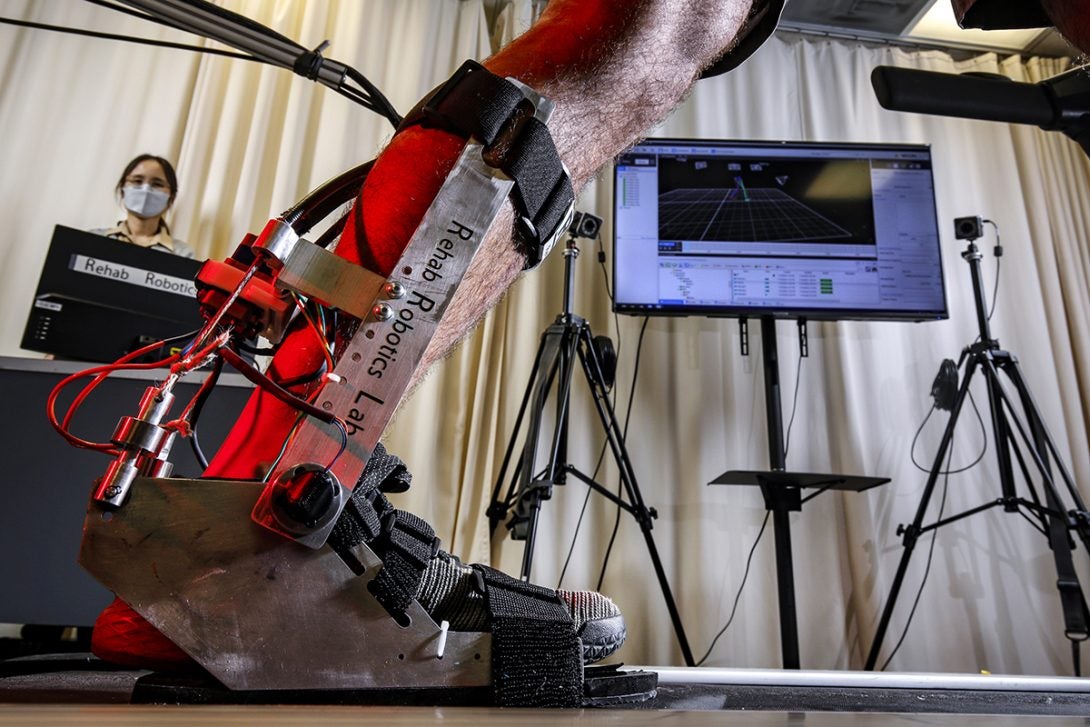Robotic limbs could make physical work easier

Robotic exoskeletons may sound like science fiction: think of the power loader in Aliens, the bio-suit in District 9, or Iron Man.
But exoskeletons are not movie make-believe. They are a real technology that stands to make a significant difference in physically intensive fields of work such as manufacturing, warehousing, and construction.
Two UIC scientists are working to make exoskeletons better and readily available to the laborers who could benefit from them. Assistant professors Myunghee Kim and Heejin Jeong of the mechanical and industrial engineering department are collaborating on a personalized lower-limb assistive wearable robot that reduces human effort during physically intensive activities. We might call it a “superboot,” but Kim and Jeong place it in the category of an “embodied intelligent system,” meaning that it senses environments and users and provides action through mechanical assistance to the user’s joints.
“The robot works by sensing a user’s physical effort using soft-wearable electronics and responding accordingly to reduce this effort,” Kim explained. “This work has significant applications in factory labor involving weight, as overexertion injuries are costly and frequently disabling.”
According to the insurance company Liberty Mutual, overexertion related to manual material-handling tasks such as lifting, pushing, and holding resulted in more than $13 billion in costs in 2019—nearly 25 percent of the company’s total for the year—and ranked first among causes of disabling injuries.
To ensure that fewer workers suffer this fate, Kim and Jeong have three main objectives in making their assistive robot a reality.
The first is customization, a process that involves finding new ways to accurately estimate a specific user’s physical effort during an activity. “If the wearable robot does not fit a person in an appropriate way, it can prevent a motion and cause an injury,” Kim said.
The second is to enhance soft-wearable electronics by replacing conventional sensors, which are rigid and uncomfortable.
The third is to evaluate the personalized assistance provided by the device when someone uses it, tracking the person’s energy expenditure, muscle activity, and other metrics. The researchers hope to provide users with real-time feedback via new display technologies such as augmented reality.
Kim and Jeong envision their robotic device as a way to lighten workers’ loads and help them avoid hazards. And workers are excited about technology that could alleviate stress on the body, ease the intensity of a job, and ultimately prevent injuries.
Michael Peach, a second-year welding apprentice and former Marine who works in the New York area, sees the benefits of an exoskeleton in his vocation and similar trades.
“It would definitely be helpful when I’m doing any overhead welding,” he said. “My body is going to hurt after a while of holding my arms up for a certain amount of time or in a certain position. Having some kind of mechanical relief would definitely increase proficiency and efficiency over any longer duration.”
Along with holding a steady position for long periods of time, welders often have to move heavy equipment throughout a work site. Kim and Jeong’s assistive robot could be valuable to laborers who need to haul items weighing 200 pounds over a distance of 200 feet, as Peach does.
William Wrublik recognizes the potential advantages of a robotic exoskeleton in his work as a laborer in the Chicago area. His varied 30-year career presently involves shipping and receiving for an international water filtration company, where each hour he might lift 30 or 40 boxes of up to 65 pounds each, some of which are weighted unevenly.
“It’s all physical,” Wrublik said. “I’ve known people who have torn shoulders, back surgery, and knee surgery. As we get older, things wear out.”
“You get tired by the time you get to the 60th or the 80th item, you are not using best form, and that’s when somebody will get hurt,” he added. “I like the possibility of having the extra support and extra strength to help.”
Because Kim and Jeong seek to improve working conditions for real people like Wrublik, they will bring their technology to market. After prototyping and pilot testing, they hope to make a product commercially available to companies and hospitals within five to 10 years. They are making international connections, but they would like to keep their R&D process local. “We would like to find some specific companies in the Chicago area to test our final product—companies that are involved in a lot of box-lifting and moving,” Jeong noted.
In addition to supporting laborers, the UIC professors’ work integrates research and education by adding a new dimension to a project-based course on wearable robotics and by providing mentorship to UIC students who are interested in assistive robots.